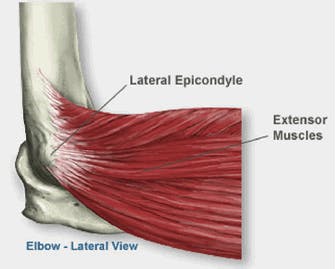By: Dr. Brian P. Kinmartin, PT, DPT, MTC, OCS, STC, CWcHP, Cert. DN

Clinically one the most common causes of elbow pain in the active aging population is known as tennis elbow or lateral epicondylitis. It is a condition where the outer part of the elbow becomes sore and tender and is commonly associated with activities requiring excessive gripping, playing tennis or other racquet sports.
Actually clinically it is very rare a true lateral epicondylitis is seen, the majority of the time it is a lateral epicondylosis. It is important to understand thedifference between tendinitis and tendinosis when determining the cause of musculoskeletal pain. Tendinitis refers to an acute inflammatory problem with a tendon due to an injury. This usually occurs by overusing a specific muscle and tendon over a short period of time which causes damage and inflammation. Tendinosis is a chronic problem within a tendon usually lasting at least 6-8 weeks in which case there is not any direct inflammation but rather a poorly organized attempt by the body to repair the tendon when damaged. This results in chronic partial or complete tendon tears and manifests itself through pain and weakness with normal or recreational activities.
One of the strongest risk factor for lateral epicondylosis is age. The peak incidence in the patient population has been shown to be between 30 to 60 years of age, it is just as likely to occur in both men and women and it has been demonstrated to more likely affect the dominant hand. Among tennis and racquet sport player's lateral epicondylosis is believed to be caused by the repetitive nature of ball hitting which intern leads to tiny tears in the forearm tendon attachment at the elbow.
The specific muscle involved in lateral epicondylosis is the extensor carpi radialis brevis muscle. This muscle begins at the lateral epicondyle of the humerus, or the boney bump on the outside of the elbow and travels up into the wrist and hand where it helps to extend and abduct the hand, or lift the wrist up and outwards towards the thumb.
Some of the more common treatments for lateral epicondylosis are; a local cortisone injection by your medical practitioner to help reduce inflammation, immobilization of the elbow for two to three weeks to help reduce inflammation and irritation, use of a counterforce brace in an attempt to take the stress off of the muscle with athletic and daily activities, and also a referral to physical therapy.
Physical Therapists are skilled medical practitioners trained in biomechanics and human anatomy. At your initial consultation the Physical Therapist will perform a mechanical examination of your elbow and wrist attempting to determine the exact cause of the irritant to the extensor carpi radialis brevis tendon which is causing the tennis elbow. From there they will develop a rehabilitation program designed around prevention and wellness including activity modification to assist in resolving your condition. This may includespecific stretches and progressive strengthening exercises to prevent re-irritation of the tendon, soft tissue mobilization may be used to help reduce the muscular tightness and reduce the tension on the tendon. Ultrasound may be used to break up scar tissue, promote healing, and increase blood flow in the area. Racquet sport players also are commonly advised by physical therapists to strengthen their shoulder rotator cuff, shoulder blade and core musculature to help reduce any overcompensation in the wrist extensors during shoulder and arm movements. Strapping of the forearm with athletic activities can help realign the muscle fibers and redistributing the load, the use of a racket designed to dampen the effect of ball striking will help to minimize the stress to the irritated or damaged tendon. All of these techniques / modalities are used by Physical Therapists to help resolve the mechanical factors contributing the dysfunction of lateral epicondylosis.
For further information on this topic or questions about obtaining a referral or making an appointment at Professional Rehab, please contact Dr. Brian P. Kinmartin, PT, DPT, MTC, OCS, STC, CWcHP, Cert. DN at our Pawleys Island office at (843) 235-0200, Richard Owen, PT, MS, OCS, Cert. SHT, CWcHP, Cert DN at our Myrtle Beach office at (843) 831-0163 or Richard DeFalco, DPT, OCS, CSCS, CWcHP, Cert. DN at our Myrtle Beach office at (843) 839-1300, or at www.prsrehabservices.com
